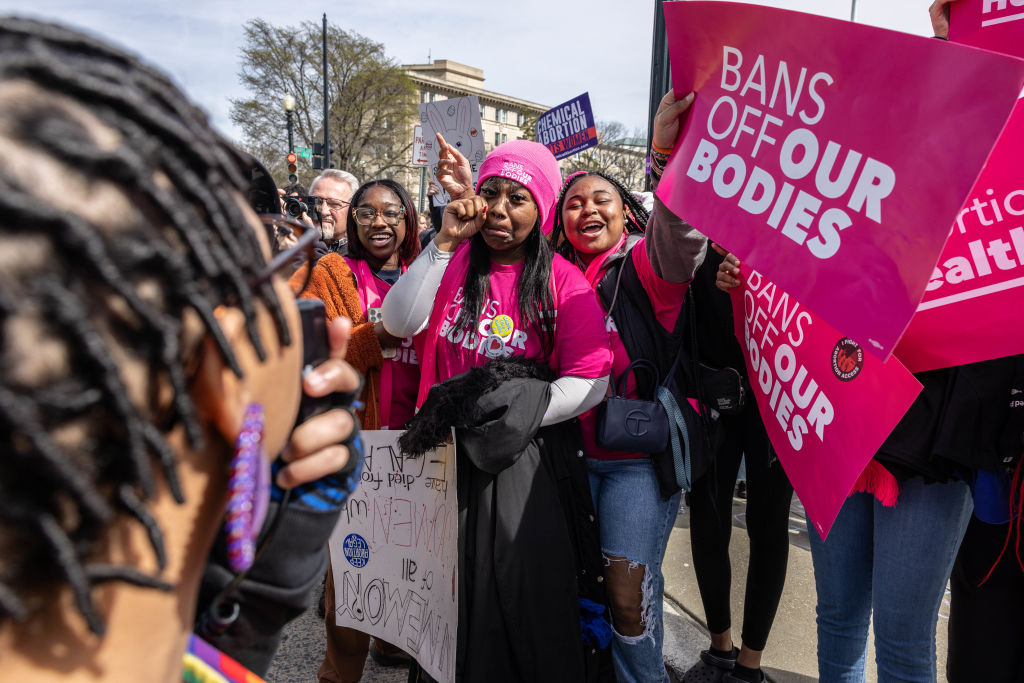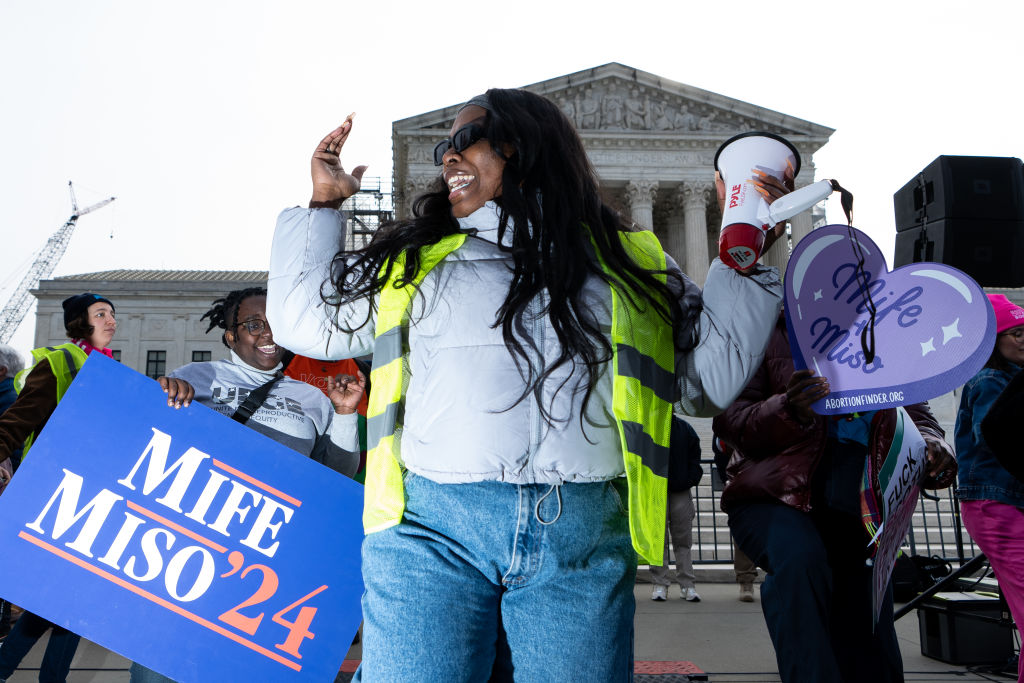When it comes to abortion pill availability, the Supreme Court left open a dangerous door that the Republican-controlled states of Missouri, Kansas and Idaho are now seeking to walk through.

At the start of the summer, the U.S. Supreme Court dismissed a case brought by antiabortion group Alliance for Hippocratic Medicine (AHM) challenging the FDA’s approval of the abortion drug mifepristone and the subsequent loosening of regulatory controls, including eliminating the in-person visit requirement. This challenge was part and parcel of the antiabortion movement’s unrelenting campaign to resurrect the Victorian-era zombie Comstock Act, an anti-obscenity law making it a crime to send or receive abortion drugs (or anything used to produce an abortion) in the mail or by a common carrier, such as FedEx, as a stealth approach to implementing a national abortion ban.
This strategy has been soundly repudiated by the Biden administration’s Department of Justice. In a legal memorandum, the DOJ made clear that Comstock is only applicable if the sender of abortion pills “intends for them to be used unlawfully,” which is virtually impossible to establish since even ban states allow abortion under specified circumstances.
However, as embodied in Project 2025, this pathway to a national abortion ban remains a shining lodestar for those committed to transforming the nation into a unified abortion wasteland.
The Court’s dismissal was based on the fact that AHM lacked standing to sue because it was not injured or likely to be injured by the FDA’s actions—such as, if member doctors had been forced to provide emergency care to women experiencing complications following a medication abortion in contravention of their antiabortion beliefs. But as the Court concluded the “causal link [was] simply too speculative or too attenuated” to support standing.
As the majority recognized, rather than seeking redress for injuries, AHM’s lawsuit was instead prompted by the desire to “make mifepristone more difficult for other doctors to prescribe and pregnant women to obtain.” Elaborating, it underscored that the standing requirement “screens out plaintiffs who might have only a general legal, moral, ideological, or policy objection to a particular government action.”
Having dismissed the case, the Court remanded it to the federal district court in Amarillo, Texas, “for further proceedings consistent with its decision.” Unfortunately, this left open a potentially dangerous door that the Republican-controlled states of Missouri, Kansas and Idaho are now seeking to walk through. Alleging that they have been directly harmed by the FDA’s actions and thus have the requisite standing to challenge the agency’s actions, they are seeking to proceed as intervenors in the case, thus keeping it alive. This is a rather chimerical assertion given that, as argued by the FDA, this would require “an existing suit … which is not present here” since the case was dismissed by the Court.
The decision regarding intervention belongs to Federalist Society member, Judge Mathew Kacsmaryk—a virulent antiabortion Trump appointee who sits in Amarillo, and the judicial lovechild of the right-wing legal establishment. Given that Kacsmaryk initially ruled in favor of AHM in an opinion that was “saturated with misleading anti-abortion tropes” and “junk science,” he is likely to be sympathetic to the states’ litany of harms.
It is rare for a patient to experience even a minor complication from a medication abortion, and the risk of death is so small as to be nearly nonexistent.
Dr. Jack Resneck, Jr.
In the challenge, Missouri, Kansas and Idaho sound the all-too-familiar post-Dobbs refrain that the authority to regulate abortion now belongs to the states. Accordingly, the federal government cannot interfere with their sovereign power to protect women and girls—as well as the unborn—from the devastating harms of abortion, which, in the present instance, flow from the FDA’s creation of a “50-state mail-order abortion economy.” Relying on scare tactics with no basis in science, they argue the states will be harmed by having to provide care to women and girls who show up in local overwhelmed emergency rooms with post-medication abortion complications.
While “a small proportion of patients do visit emergency rooms after an abortion,” Dr. Ushma Upadhyay, a public health social scientist at Advancing New Standards in Reproductive Health (ANSIRH) said, “it’s usually for a variety of other reasons that aren’t related to the pill’s safety profile.” Common reasons include ensuring that the abortion is complete and managing symptoms, such as heavy bleeding or painful cramps.

Ironies abound in the states’ wildly exaggerated claims about the dangers of medication abortion. Not only do they ignore the “hundreds upon hundreds of peer-reviewed clinical studies and decades of evidence-based research … [that] demonstrate the safety of mifepristone, which has a safety profile comparable to ibuprofen,” they are impervious to the comparative risks of pregnancy and abortion.
Dr. Jack Resneck, Jr., former president of the AMA, explained:
It is rare for a patient to experience even a minor complication from a medication abortion, and the risk of death is so small as to be nearly nonexistent. Continuing a pregnancy poses far greater danger; the risk of death during or after childbirth is approximately 14 times higher than the risk of death from abortion-related complications” with the risk of severe maternal morbidity being greatest for “people of color (especially Black women), those with low incomes and those living in rural areas.”
The states also elide the nightmarish stories coming out of abortion ban states, such as Georgia and Texas, where women have died or experienced life-threatening complications as a direct result of being denied critical abortion care.
There is also great irony in the state’s invocation of the federal Comstock Act to support their claim that the FDA’s loosening of restrictions represents a deliberate effort to upend their sovereign authority over abortion. In so doing, they themselves are calling upon the power of federal law to cut off access to medication abortion in states where abortion is legal—thus upending their sovereign authority.
Invoking the religiously inspired “pro-woman/pro-life” antiabortion trope, the states also allege that it is incumbent upon them to protect resident women and girls from the “distress and regret” associated with medication abortion.
Again ignoring the volume of evidence-based studies establishing that the majority of women believe abortion was the right choice, they rely upon a “study” which is actually a review of blog posts on, as reported by Jessica Valenti, a “site funded by Life Perspectives … a group that provides materials to Heartbeat International, the largest network of anti-abortion crisis pregnancy centers.”
They further argue that their protective duty is compounded by an additional harm unique to medication abortions—namely, that those aborting at home are “likely to continue associating their homes, or the bathroom, with abortion. The home may become a trigger for uncomfortable emotions rather than a refuge.” This, of course, overlooks the harsh reality that it is the lack of abortion access that can make home feel less like a “refuge” to those trapped there by an unwanted pregnancy or life-threatening complications that doctors refuse to treat, or in situations where one is “doubly endangered by domestic violence and pregnancy.”
When it comes to pregnant teens, the states zero in on those in state custody claiming that the FDA has “sought to interfere with and nullify the States’ exercise of state-law parental rights for children in state custody, such as teen girls in the foster care system.” By limiting their focus to this subset of teens, the states are able to construct an argument that the “FDA’s deregulatory actions” has deprived them of their rights as legal parents to consent to the abortion. By casting themselves as the parents of teens who are “susceptible to pregnancy and to seeking abortions,” the states are seeking to capitalize on the increasingly powerful parental rights movement.
However, they fail to see that the movement is committed to—as the Moms for Liberty proclaim—fighting for “the survival of America by unifying, educating and empowering parents to defend their parental rights at all levels of government.” In short, the displacement of federal authority by the exercise of state custodial control over their children certainly does not qualify as liberating parents from governmental interference with their claimed right to raise their children as they see fit.
This brings us to the most bizarre claim of injury: In a silent nod to the “pro-natalist” movement—which seeks to reverse falling birth rates in industrialized countries by persuading “childless cat ladies” to procreate—the states claim that as a result of the FDA’s deregulatory actions, they have suffered “injuries from the loss of fetal life and potential births, leading to a resulting reduction in the actual or potential population of each state.”
They astutely point out that “each abortion represents at least one lost potential or actual birth,” including lowered “expected birth rates for teenaged mothers” within their respective borders. Not only do they claim that the depressed birth rate is “a sovereign injury to the State in itself,” but also that the harm will be compounded by the resulting loss of “’political representation and … ‘federal funds.’” It is here that the antiabortion movement’s pro-natalist commitment is laid out in its starkest manifestation.
As made clear, the relentless post-Dobbs crusade to block access to abortion by any means possible represents a power grab by states aimed at forcing pregnant people, including teens, to bear children by legal fiat.
At Ms. magazine, our mission is to deliver facts about the feminist movement (and those who stand in its way) and foster informed discussions—not to tell you who to vote for or what to think. We believe in empowering our readers to form their own opinions based on reliable reporting. To continue providing you with independent feminist journalism, we rely on the generous support of our readers. Please consider making a tax-deductible donation today if you value the work we do and want to see it continue. Thank you for supporting women’s voices and rights.





